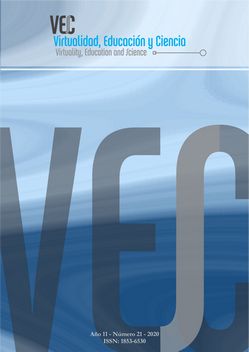The multimodal perspective in the study of VLE. The discovery of the obvious
DOI:
https://doi.org/10.60020/1853-6530.v11.n21.29433Keywords:
multimodal semiotic; VLE; analysis, multimodal text; interpretationAbstract
This work aims at an account of the relevance of the multimodal semiotic perspective for the analysis of virtual teaching and learning environments (VLE). For this purpose, the theory is framed in the paradigm that originated. The fundamental elements of theory are defined and characterized: ‘multimodal’, ‘mode', ‘modality', 'text' and 'genre multimodal. They operate as interpretive codes of textual productions and focus on certain aspects and problems that help to structure and understand reality. At the same time, they attribute an order and an interpretive logic to multimodal production. The conclusion stemmed from the microanalysis was an inescapable need for this approach due to changes in reading and writing practices in environments mediated by technology and in the subjects immersed in them.
References
AREA, M.; RIBEIRO, T. (2012) De lo sólido a lo líquido: Las nuevas alfabetizaciones ante los cambios culturales de la Web 2.0. Comunicar (38), 13-20. https://doi.org/10.3916/C38-2012-02-01
BAL, M. (2004). El esencialismo visual y el objeto de los Estudios Visuales. Revista de Estudios Visuales. 2, Barcelona: Akal.
BARBERÀ, E.; BADIA, A. (2005). Hacia el aula virtual. Actividades de enseñanza y aprendizaje en la red. Revista Iberoamericana de Educación. OEI. Recuperado de: http://rieoei.org/index.php
BATEMAN, J. A. (2008) Multimodality and Genre – A foundation for the systematic analysis of multimodal documents. London: Palgrave Macmillan.
BEZEMER, J.; KRESS, G. (2016) Multimodality, Learning and Communication. Abingdon, Oxon: Routledge.
COBO ROMANÍ, C.; PARDO KUKLINSKI, H. (2007) Planeta Web 2.0. Inteligencia colectiva o medios fast food. Barcelona/ México DF: Grup de Recerca d'Interaccions Digitals, Universitat de Vic. Flacso México.
HALLIDAY, M.; MATTIESSEN, C. (2004) An Introduction to Functional Grammar. London: Hodder Arnold.
HALLIDAY, M.A.K. (2013) El lenguaje como semiótica social. México: FCE.
JEWITT, C.; BEZEMER, J.; O’HALLORAN, K. (2016). Introducing Multimodality. London: Routledge.
JOHANNESSEN, C. M. (2017). Experiential meaning potential in the Topaz Energy logo: a framework for graphemic and graphetic analysis of graphic logo design, Social Semiotics. 27(1): 1-20.
KRESS, G.; VAN LEEUWEN, T. (1996) Reading images. London: Routledge.
KRESS, G. y VAN LEEUWEN, T. (2001). Multimodal discourse: the modes and media of contemporary communication. London: Arnold.
KRESS, G. (2003). Literacy in the New Media Age. Abingdon: Routledge.
KRESS, G. (2005). El alfabetismo en la era de los nuevos medios de comunicación. Granada: Ediciones El Aljibe-Enseñanza Abierta de Andalucía.
KRESS, G. y VAN LEEUWEN, T. [1996] (2006). Reading Images. The Grammar of Visual Design.2nd ed. London: Routledge.
KRESS, G. (2010). Multimodality: a social semiotic approach to contemporary communication. 1º ed. USA: Routledge.
O’HALLORAN, K. (2004). Multimodal discourse Analysis. London: Continuum, Open Linguistic series.
O’REILLY, T. (2018) What Is Web 2.0. Design Patterns and Business Models for the Next Generation of Software. Recuperado de: https://www.oreilly.com/pub/a/web2/archive/what-is-web-20.html 30 de junio 2018.
PARODI, G. (2010). Multisemiosis y Lingüística de corpus: artefactos (Multi) Semióticos en los textos de seis disciplinas en el corpus
PUCV-2010. Revista de Lingüística Teórica y Aplicada. Chile: 48(2) II Sem. (pp 33-70). Recuperado de: https://scielo.conicyt.cl/scielo.php?pid=S0718-48832010000200003&script=sci_arttext
PÉREZ, S. (2009). Los medios y los modos: una mirada semiótica a los entornos virtuales de aprendizaje. En S. Pérez y A. Imperatore (Comp.), Comunicación y Educación en entornos virtuales de aprendizaje: perspectivas teórico-metodológicas. 1a ed. (pp. 55-66) Bernal: Universidad Nacional de Quilmes, Panel de Expertos I.
POULSEN, S. V. (2015). Multimodal meaning-making. En Key Terms in Multimodality: Definitions, Issues, Discussions. Edited by Nina Nørgaard. Recuperado de: https://multimodalkeyterms.wordpress.com/
PRESSMAN, R. (2002). Ingeniería del Software. Un enfoque práctico. 5ª ed. México: McGraw-Hill.
UNSWORTH, L. (2011) Multimodal Semiotic. Functional Analysis in Contexts of Education. London: Bloomsbury Academic.
VAN LEEUWEN, T. (2005). Introducing Social Semiotics. Abingdon, Oxon.: Routledge.
VAN LEEUWEN, T. (2011). The Language of Colour. London: Routledge.
VAN LEEUWEN, T. (2011). Key Terms in Multimodality: Definitions, Issues, Discussions. Editado por Nina Nørgaard. Recuperado de: https://multimodalkeyterms.wordpress.com/
VAN LEEUWEN, T. (2015). Introduction to Multimodal integration. Paper presentation given at DNC#1: DiscourseNet International Congress. Bremen University.
VÁSQUEZ-ROCCA, L. y PARODI, G. (2015). Relaciones retóricas y multimodalidad en el género informe de Política monetaria del discurso académico de la Economía. Calidoscopio. 13(3) pp. 388-405. Recuperado de: http://www.giovanniparodi.cl/giovanniparodi/site/artic/20160901/asocfile/20160901115817/10044_36883_1_pb.pdf
YNOUB, R. (2014) Cuestión de Método. Aportes para una metodología crítica. México, DF.: Cengage Learning Editores SA.
Downloads
Published
Issue
Section
License
Copyright (c) 2020 Virtuality, Education and Science

This work is licensed under a Creative Commons Attribution-NonCommercial 4.0 International License.
The generation of derivative works is allowed as long as it is not done for commercial purposes. The original work may not be used for commercial purposes.


